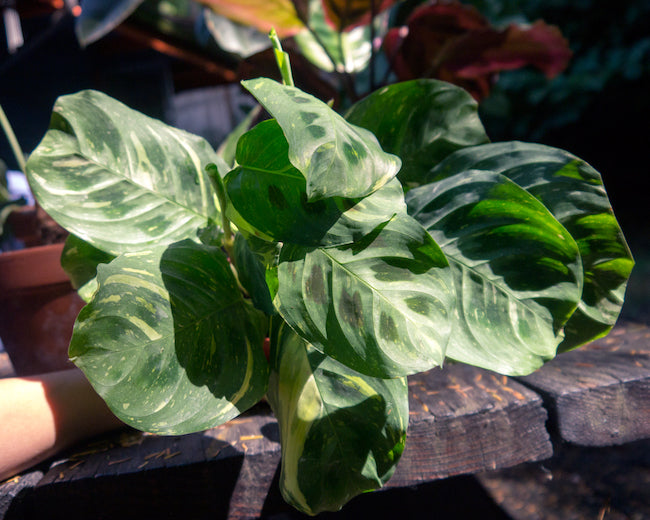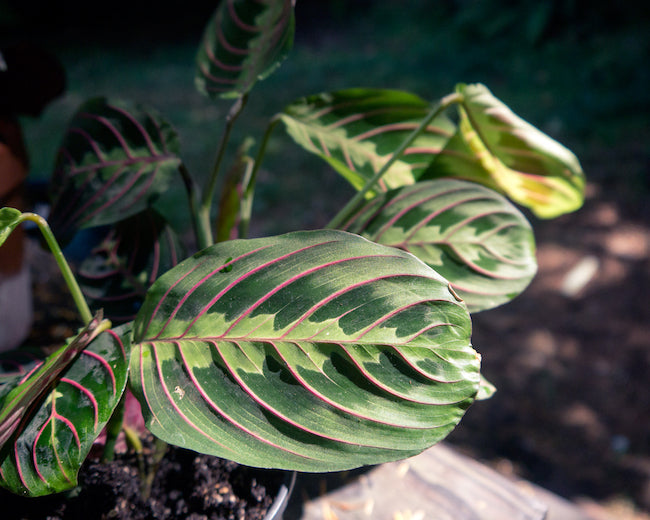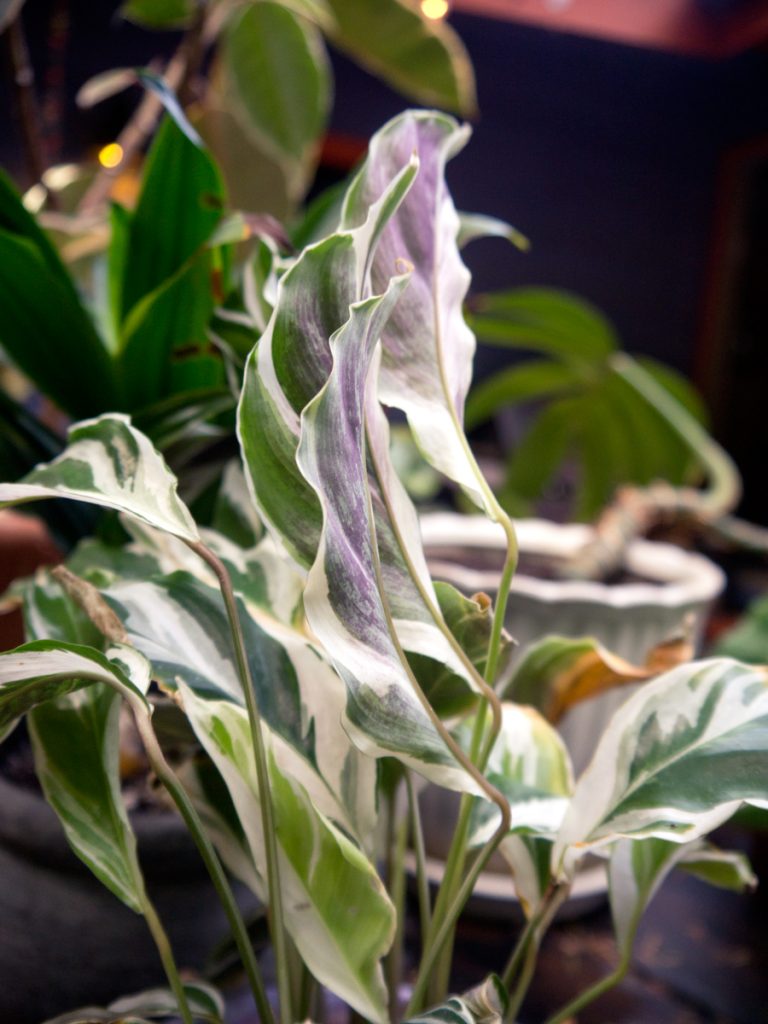
Maranta leuconeura var kerchoveana 'Variegata'
Also known as the arrowroot family, some species are cultivated for the arrowroot supplied in large starchy rhizomes. Other species have been used in basket weaving and wax extraction. These rhizomatous tropicals often reside in the understory of tropical forests where they have adapted to a humid atmosphere and low light conditions. As a result, prayer plants make excellent houseplants because of their ornate foliage and low light requirements.
Marantaceae are from the ginger order (Zingerbarales) and are spread across over 30 genera and 550 species. Popular houseplant genera include Goeppertia, Maranta, Calathea, Ctenanthe and Stromanthe. Though there is still some debate in the scientific community about what makes the leaves move, some studies show that they use their leaf movement mechanism as protection from late day sun radiation.
Although these stunners have a reputation for being fussy, with a few tips your prayer plants will thrive!
General Care Tips for Prayer Plants
Light– Although the amount of diffusion can vary between different species, generally all Marantaceae enjoy medium indirect light. In front of a north, or near an east facing window is great. If keeping these plants in rooms with west or south facing windows find a bright protected area away from the direct shine of the sun.

Calathea lancifolia, Ctenanthe burle-marxii, Calathea 'Beauty Star,' Maranta leuconeura 'Marisela,' Calathea rufibarba, and Calathea makoyana
Water – Watering is a pretty regular occurrence for a prayer plant owner, especially if you’re planting in a terracotta pot. Prayer plants do not like to dry out, so it’s essential to water when just the first inch or two of the soil are dry. This could be as often as every 3-5 days in the summer, depending on factors like temperature, humidity and light in your space – definitely check on your plants often!
Prayer Plants also don’t like to have their roots sitting in water for extended periods. When picking out a pot, a drainage hole is highly recommended for these plants, as well as some horticultural charcoal or pumice at the bottom of the pot to allow for better drainage. If you find that your plant is having chlorosis (yellowing leaves), it could be caused by poor drainage or from salt and mineral build up.
You might also consider using distilled water, or collect rain water for your prayer plants. They are from an area where most of the salts and minerals are purified by the rain and their rhizomes can suffer from exposure to salts, minerals and chemicals.
Soil – Pick a well-draining tropical mix will support vital nutrients for your plants as well as allow for proper drainage. You can create your own mix with worm castings, pumice, peat moss, and orchid bark or coco coir.
Food – Feed your prayer plant on a monthly or bi-monthly basis through out the growing season (spring, summer, fall) by diluting any synthetic fertilizer by a quarter or use a low dose natural fertilizer.
Other tips – Be careful of placing your plant near drafty windows or heaters that will dry out your plant. Spritz the leaves of your plant, add a humidifier, or leave a decorative glass of water out next to your plant to increase humidity. If the leaf tips are browning and getting crispy it likely because there’s not enough humidity in its environment. Repotting your plants every 2-3 years will ensure happy growth. The best time to replant is spring.

Our favorite Prayer Plant genera and species
Fortunately, Prayer Plants are widely cultivated, with new, beautiful cultivars regularly becoming available! Species in genera such as Calathea, Maranta, Ctenanthe, and Stromanthe make particularly lovely houseplants.
Here are some of our favorite varieties!
- Maranta leuconeura – This cutie makes a great hanging plant or shelf plant. They have a scandent growth pattern, meant to spread across the forest floor. It is said to be one of the easiest prayer plants to care for, and with stunning pattern and color variations these plants are a must get.
- Calathea lancifolia – Also know as Rattlesnake Plant, this long narrow-leafed calathea is also considered the easiest in the family. She’s cute, with her ornate studded leaves with ruby backsides.
- Calathea ornata – Also known as Pinstripe Plant, is a somewhat darker green species that prefers more diffused light than others. Check out one its cultivars, Beauty Star, which has light green diffused through the leaf and is said to be easier to get the light requirements right.
- Calathea roseopicta – This species has been cultivated into many color varieties ranging from dark purple, to the stunning medallion variety. The roseopicta’s leaves can get quite large and round making it a real eye catcher.
- Calathea leitzii 'Fusion White' – This variegated Calathea was a plant mutation discovered by accident at a nursery in Malaysia — and it’s quite a sight to see! It looks as though someone painted little white brush strokes along the leaf, with lilac purple backsides. Although it is known to be a tricky house plant, with persistent watering, maintaining some level of humidity, and the right diffused bright light this plant will flourish in your home.

Calathea 'Fusion White'
- Stromanthe sanguinea – Native to Mexico and Argentina this dark leaf beauty has purple undersides and a silver stripe down the midrib. Stromanthe can get taller than some other Prayer Plants with long slender leaves. The Triostar cultivar with it’s pink and white variegation is a fun alternative.
- Ctenanthe burle-marxii – Named after the famed botanist Burle Marx, this Ctenanthe’s other common name is Fishbone Prayer Plant, named after the intricate dark bone like patterns on otherwise minty leafs. This prayer plant grows in a circular pattern, and can be more adaptable to brighter light than most other Prayer Plants.
With these tips under your belt, Marantaceae may well be your favorite new houseplant family. Happy planting!
By: Amelia Ralston Okabayashi

Comments
Really love your website! Please talk more about propagating and soil mixes for each spieces of plant. Also have some great deals for us to purchase! :)
A very good site of indoor plants,i need more information about propagation